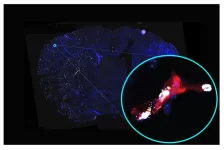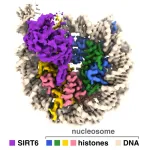(Press-News.org) **Note: the release below is from the European Congress of Clinical Microbiology & Infectious Diseases (ECCMID 2023, Copenhagen, 15-18 April). Please credit the conference if you use this story**
Evidence that multidrug-resistant bacteria are being passed between pet cats and dogs and their owners will be presented at this year’s European Congress of Clinical Microbiology & Infectious Diseases (ECCMID) in Copenhagen, Denmark (15-18 April).
Six pets in Portugal and one in the UK were carrying antibiotic-resistant bacteria similar to those found in their owners, a Portuguese study found.
The finding underlines the importance of including pet-owning households in programmes to reduce the spread of antimicrobial resistance.
Antibiotic resistance is reaching dangerously high levels around the world. Drug-resistant infections kill an estimated 700,000 people a year globally and, with the figure projected to rise to 10 million by 2050 if no action is taken, the World Health Organisation (WHO) classes antibiotic resistance as one of the greatest public health threats facing humanity.
Dogs, cats and other pets are known to contribute to the spread of antibiotic-resistant pathogens that can cause human disease. Juliana Menezes and colleagues from the Antibiotic Resistance Lab at the Centre of Interdisciplinary Research in Animal Health, Faculty of Veterinary Medicine, University of Lisbon, Portugal wanted to find out if pets being treated with antibiotics for infections are sharing such pathogens with their owners.
The researchers tested faecal samples from dogs and cats and their owners for Enterobacterales (a large family of bacteria which includes E. coli and Klebsiella pneumoniae) resistant to common antibiotics.
They focused on bacteria resistant to third generation cephalosporins (used to treat a broad range of conditions, including meningitis, pneumonia and sepsis, they are classed among the most critically important antibiotics for human medicine by the World Health Organisation) and carbapenems (part of the last line of defence when other antibiotics have failed).The prospective longitudinal study involved five cats, 38 dogs and 78 humans from 43 households in Portugal and seven dogs and eight humans from seven households in the UK.
In Portugal, one dog (1/43 pets, 2.3%) was colonised by a strain of multidrug-resistant OXA-181-producing Escherichia coli. OXA-181 is an enzyme that confers resistance to carbapenems.
Three cats and 21 dogs (24/43 pets, 55.8%) and 28 owners (28/78, 35.9%) harboured ESBL/Amp-C producing Enterobacterales. These are resistant to third generation cephalosporins.
In eight households, two houses with cats and six with dogs, both pet and owner were carrying ESBL/AmpC-producing bacteria. In six of these homes, the DNA of the bacteria isolated from the pets (one cat and five dogs) and their owners was similar, meaning these bacteria were probably passed between the animals and humans. It is not known whether they were transferred from pet to human or vice versa.
In the UK, one dog (1/7,14.3%) was colonised by multidrug-resistant E. coli producing NDM-5 and CTX-M-15 beta-lactamases. These E. coli are resistant to third generation cephalosporins, carbapenems and several other families of antibiotics.
ESBL/AmpC-producing Enterobacterales were isolated from five dogs (5/7, 71.4%) and three owners (3/8, 37.5%).
In two households with dogs, both pet and owner were carrying ESBL/AmpC-producing bacteria. In one of these homes, the DNA of the bacteria isolated from the dog and owner was similar, suggesting the bacteria probably passed from one to the other. The direction of transfer is unclear.
All of the dogs and cats were successfully treated for their skin, soft tissue and urinary tract infections.
The owners did not have infections and so did not need treatment.
Ms Menezes, a PhD student, says: “In this study, we provide evidence that bacteria resistant to a third generation cephalosporins, critically important antibiotics, are being passed from pets to their owners.
“Dogs and cats may aid the spread and persistence of such bacteria in the community and it is vitally important that they are included in assessments of antimicrobial resistance.
“Owners can reduce the spread of multidrug-resistant bacteria by practising good hygiene, including washing their hands after collecting their dog or cat’s waste and even after petting them.”
Juliana Menezes, Centre for Interdisciplinary Research in Animal Health, Faculty of Veterinary Medicine, University of Lisbon, Portugal. T) +351 21 365 2837 E) julianamenezes@fmv.ulisboa.pt
Professor Constança Pomba, Team leader of the Antibiotic Resistance Lab at the Centre for Interdisciplinary Research in Animal Health, Faculty of Veterinary Medicine, University of Lisbon, Portugal. T) +351 21 365 2837 E) cpomba@fmv.ulisboa.pt
Alternative contact: Tony Kirby in the ECCMID Media Centre. T) +44 7834 385827 E) tony@tonykirby.com
Notes to editors:
The authors declare no conflicts of interest.
The work was supported by JPIAMR/0002/2016 Project—PET-Risk Consortium and by FCT – Fundação para a Ciência e Tecnologia IP (UIDB/00276/2020); JM and JMS were supported by a PhD fellowship (2020.07562.BD; 2020.06540.BD, respectively).
This press release is based on oral presentation 208 at the European Congress of Clinical Microbiology & Infectious Diseases (ECCMID) annual meeting. The material has been peer reviewed by the congress selection committee. There is no full paper at this stage and, as it is an oral presentation, there is no poster.
END
UK-Portuguese study shows antibiotic-resistant “superbugs” are being passed between dogs and cats and their owners, study strongly suggests
People in UK and Portugal carrying same multidrug-resistant bacteria as their pets; call for dogs and cats to be included in assessments of antibiotic resistance
2023-04-15
ELSE PRESS RELEASES FROM THIS DATE:
Study of cerebral blood vessels uncovers potential new drug targets for treating stroke
2023-04-14
Strokes cause numerous changes in gene activity in affected small blood vessels in the brain, and these changes are potentially targetable with existing or future drugs to mitigate brain injury or improve stroke recovery, according to a study led by Weill Cornell Medicine scientists.
In the study, which appears Apr. 14 in the Proceedings of the National Academy of Sciences, the researchers performed a comprehensive survey, in a preclinical model, of gene activity changes in small blood vessels in the brain following stroke. Comparing these changes to those that have been recorded in stroke patients, they catalogued hundreds ...
Tracking a new path to octopus and squid sensing capabilities
2023-04-14
Along their eight arms, octopuses have highly sensitive suckers that allow methodical explorations of the seafloor as they search for nourishment in a “taste by touch” approach. Squids, on the other hand, use a much different tactic to find their next meal: patiently hiding until they ambush their prey in swift bursts.
In a unique analysis that provides a glimpse into the origin stories of new animal traits, a pair of research studies led by University of California San Diego and Harvard University scientists has traced the evolutionary adaptations of octopus and squid sensing capabilities. The studies, featured on ...
Trees in savanna areas of Cerrado produce three times more bark than species in forest areas
2023-04-14
In tropical regions of the planet, savannas and forests often coexist in the same area and are exposed to the same climate. An example is the Cerrado, a Brazilian biome that includes several types of vegetation, from broad-leaved and sclerophyllous in dense woodland or shrubland (cerrado sensu stricto) to semi-evergreen in closed-canopy forest (cerradão), as well as grassland with scattered shrubs (campo sujo) and even semi-deciduous seasonal forest.
Areas of cerradão develop in the absence of fire, in both poor and moderately fertile soil (dystrophic to mesotrophic).
This coexistence intrigues botanists and ecologists ...
Wayne State researcher receives $1.95 million NIH grant to study impact of inositol homeostasis on essential cellular functions
2023-04-14
DETROIT – A researcher from Wayne State University’s Department of Biological Sciences has received a five-year, $1.95 million grant from the National Institute of General Medical Sciences of the National Institutes of Health to identify mechanisms that regulate inositol synthesis in mammalian cells and determine the cellular consequences of inositol depletion.
Inositol is a type of sugar that is essential for the viability of eukaryotic cells. Myo-inositol is the precursor of all inositol compounds, which play pivotal roles in cell signaling and metabolism. Consistent with its importance, a disturbance of inositol homeostasis ...
Head and neck, breast cancer research highlights University of Cincinnati AACR abstracts
2023-04-14
University of Cincinnati Cancer Center researchers will present more than a dozen abstracts at the American Association for Cancer Research Annual Meeting 2023, held in Orlando, Florida, April 14-19, including findings that could advance treatments for head and neck and breast cancers.
Enzyme shows promise as target to treat HPV negative head and neck cancer
Vinita Takiar’s lab in UC’s Department of Radiation Oncology studies how to improve radiation therapy for head and neck cancer patients.
Julianna Korns, a doctoral student working in Takiar’s lab, and her colleagues study an enzyme called Plk1 that allows healthy cells to divide ...
Scientists develop new way to measure wind
2023-04-14
Wind speed and direction provide clues for forecasting weather patterns. In fact, wind influences cloud formation by bringing water vapor together. Atmospheric scientists have now found a novel way of measuring wind – by developing an algorithm that uses data from water vapor movements. This could help predict extreme events like hurricanes and storms.
A study published by University of Arizona researchers in the journal Geophysical Research Letters provides, for the first time, data on the vertical distribution of horizontal winds ...
Ancient DNA reveals the multiethnic structure of Mongolia’s first nomadic empire
2023-04-14
Long obscured in the shadows of history, the world’s first nomadic empire - the Xiongnu - is at last coming into view thanks to painstaking archaeological excavations and new ancient DNA evidence. Arising on the Mongolian steppe 1,500 years before the Mongols, the Xiongnu empire grew to be one of Iron Age Asia’s most powerful political forces - ultimately stretching its reach and influence from Egypt to Rome to Imperial China. Economically grounded in animal husbandry and dairying, the Xiongnu were famously nomadic, building their empire on the backs of horses. ...
2022 Tongan volcanic explosion was largest natural explosion in over a century, new study finds
2023-04-14
The 2022 eruption of a submarine volcano in Tonga was more powerful than the largest U.S. nuclear explosion, according to a new study led by scientists at the University of Miami Rosenstiel School of Marine, Atmospheric, and Earth Science and the Khaled bin Sultan Living Oceans Foundation.
The 15-megaton volcanic explosion from Hunga Tonga-Hunga Ha'apai, one of the largest natural explosions in more than a century, generated a mega-tsunami with waves up to 45-meters high (148 feet) along the coast of Tonga’s Tofua Island and waves up to 17 meters (56 feet) on Tongatapu, ...
How does an aging-associated enzyme access our genetic material?
2023-04-14
UNIVERSITY PARK, Pa. — New research provides insight into how an enzyme that helps regulate aging and other metabolic processes accesses our genetic material to modulate gene expression within the cell. A team led by Penn State researchers have produced images of a sirtuin enzyme bound to a nucleosome—a tightly packed complex of DNA and proteins called histones—showing how the enzyme navigates the nucleosome complex to access both DNA and histone proteins and clarifying how it functions in humans and other animals.
A paper describing the results appears April 14 in the journal ...
Aston University develops software to untangle genetic factors linked to shared characteristics among different species
2023-04-14
Has potential to help geneticists investigate vital issues such as antibacterial resistance
Will untangle the genetic components shared due to common ancestry from the ones shared due to evolution
The work is result of a four-year international collaboration.
Aston University has worked with international partners to develop a software package to help scientists answer key questions about genetic factors associated with shared characteristics among different species.
Called CALANGO (comparative analysis with annotation-based genomic ...
LAST 30 PRESS RELEASES:
Scientists to ‘spy’ on cancer- immune cell interactions using quantum technology breakthrough
Tech savvy users have most digital concerns
Making lighter work of calculating fluid and heat flow
Normalizing blood sugar can halve heart attack risk
Lowering blood sugar cuts heart attack risk in people with prediabetes
Study links genetic variants to risk of blinding eye disease in premature infants
Non-opioid ‘pain sponge’ therapy halts cartilage degeneration and relieves chronic pain
AI can pick up cultural values by mimicking how kids learn
China’s ecological redlines offer fast track to 30 x 30 global conservation goal
Invisible indoor threats: emerging household contaminants and their growing risks to human health
Adding antibody treatment to chemo boosts outcomes for children with rare cancer
Germline pathogenic variants among women without a history of breast cancer
Tanning beds triple melanoma risk, potentially causing broad DNA damage
Unique bond identified as key to viral infection speed
Indoor tanning makes youthful skin much older on a genetic level
Mouse model sheds new light on the causes and potential solutions to human GI problems linked to muscular dystrophy
The Journal of Nuclear Medicine ahead-of-print tip sheet: December 12, 2025
Smarter tools for peering into the microscopic world
Applications open for funding to conduct research in the Kinsey Institute archives
Global measure underestimates the severity of food insecurity
Child survivors of critical illness are missing out on timely follow up care
Risk-based vs annual breast cancer screening / the WISDOM randomized clinical trial
University of Toronto launches Electric Vehicle Innovation Ontario to accelerate advanced EV technologies and build Canada’s innovation advantage
Early relapse predicts poor outcomes in aggressive blood cancer
American College of Lifestyle Medicine applauds two CMS models aligned with lifestyle medicine practice and reimbursement
Clinical trial finds cannabis use not a barrier to quitting nicotine vaping
Supplemental nutrition assistance program policies and food insecurity
Switching immune cells to “night mode” could limit damage after a heart attack, study suggests
URI-based Global RIghts Project report spotlights continued troubling trends in worldwide inhumane treatment
Neutrophils are less aggressive at night, explaining why nighttime heart attacks cause less damage than daytime events
[Press-News.org] UK-Portuguese study shows antibiotic-resistant “superbugs” are being passed between dogs and cats and their owners, study strongly suggestsPeople in UK and Portugal carrying same multidrug-resistant bacteria as their pets; call for dogs and cats to be included in assessments of antibiotic resistance







